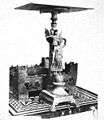Brazier
A brazier /ˈbreɪʒər/ is a container for hot coals, generally taking the form of an upright standing or hanging metal bowl or box. Used for burning solid fuel, usually charcoal, braziers principally provide heat, but may also be used for cooking and cultural rituals. Braziers have been recovered from many early archaeological sites like the Nimrud brazier, recently excavated by the Iraqi National Museum, which dates back to at least 824 BCE.[1]
History

Braziers are mentioned in the Bible. The Hebrew word for brazier is of Egyptian origin, suggesting that it was imported from Egypt. The only reference to it in the Bible is in Jeremiah 36:22–23, with braziers heating the winter palace of King Jehoiakim.
The Roman Emperor Jovian was poisoned by the fumes from a brazier in his tent in 364, ending the line of Constantine.
Uses
Heating
Despite the risks associated with burning charcoal on open fires, braziers were widely adopted as a source of domestic heat, particularly in the Spanish-speaking world. Fernando de Alva Cortés Ixtlilxochitl notes that the Tepanec Tlatoani in New Spain slept between two braziers because he was so old he produced no natural heat. Nineteenth century British travellers such as diplomat and scientist Woodbine Parish and the writer Richard Ford, author of A Handbook for Travellers in Spain, state that in many areas braziers were considered healthier than fireplaces and chimneys.[2][3]
The brazier did not just sit out in the open, in a room; often it was incorporated into furniture. Many cultures developed their own variants of a low table, with a heat source underneath and blankets to capture the warmth: the kotatsu in Japan, the korsi in Iran, the sandali in Afghanistan,[4] and the foot stove in northern Europe. In Spain the brasero continued to be one of the primary means of heating houses until the early 20th century; Gerald Brenan described in his memoir South from Granada the widespread habit there in the 1920s of placing a brazier beneath a cloth-covered table to keep the legs and feet of the family warm on winter evenings.[5]
Scent
When burned moist, rose and grapevine trimmings produce a pungent, sweet-smelling smoke, and make very good charcoal. When the charcoal fumes became overbearing, however, aromatics (lavender seeds, orange peel) were sometimes added to the embers in the brazier.[3] A brazier used exclusively for burning aromatics (incense) is known as a censer or thurible.
Other
In some churches a brazier is used to create a small fire, called new fire, which is then used to light the Paschal candle during the Easter Vigil.
Braziers used to be a commonplace sight on industrial picket lines, although as strikes in the UK have become increasingly white collar, they are seen less and less.[6]
In Japanese, a brazier is called a hibachi. They are used principally for cooking and in cultural rituals such as the Japanese tea ceremony.
Gallery
- Simple Brazier
 Pompeii, Italy. Table and small brazier to keep food warm. Brooklyn Museum Archives, Goodyear Archival Collection
Pompeii, Italy. Table and small brazier to keep food warm. Brooklyn Museum Archives, Goodyear Archival Collection- Brazier used for lighting the Paschal candle during Easter Vigil.
See also
| Look up brazier in Wiktionary, the free dictionary. |
| Wikimedia Commons has media related to Braziers (fire container). |
| Wikisource has the text of the 1911 Encyclopædia Britannica article Brazier. |
- Angithi, a traditional Indian brazier
- Barbecue grill
- Chafing dish, a cooking implement
- Hibachi, a Japanese brazier
- List of cooking appliances
- Torch
- Cresset, a cup for burning oil
- Kanger, a traditional Kashmiri personal heating device
References
- ↑ Russell, John M. (November 2003). "The MPs Do It Again: Two More Antiquities from the Top 30 Are Back in the Iraq Museum" (PDF). Archaeological Institute of America. Retrieved 2014-08-10.
- ↑ Parish, Sir Woodbine (1839). Buenos Ayres and the Provinces of the Rio de La Plata; Their Present State, Trade and Debt. John Murray.
- 1 2 Ford, Richard (1845). A Handbook for Travellers in Spain. John Murray.
- ↑ Jessica Barry. "Afghanistan: Sandali stoves, a blessing and a curse". ICRC. Retrieved 3 May 2016.
- ↑ Brenan, Gerald (1957). South from Granada. Hamish Hamilton. ISBN 9780241890028.
- ↑ Bennett, Catherine (2001-11-28). "Every strike needs a brazier". The Guardian. Retrieved 2014-08-10.